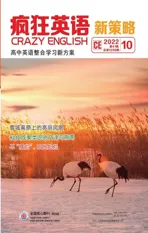雪域高原上的亮丽风景
2022-10-21河南刘同功
河南 刘同功
一只编号为“V021”的黑颈鹤于去年春天在云南会泽黑颈鹤国家级自然保护区附近获救,经过悉心的照顾,它最终回归了大自然。

主题语境:生态保护 篇幅:322词 建议用时:6分钟
One black-necked crane,codenamed (编号)V021,has had an unusual year.Rescued near a national nature reserve in Yunnan Province last spring, the young crane was injured and had been left behind when the rest of its flock migrated.
After a week in care, the bird was released by Wu Heqi, a researcher from the Chinese Academy of Sciences, after it was tagged to track its movements by satellite. The tag was emblazoned with a“V”, which Wu explained stood for“victory”, and it was hoped that the bird's release would lead to its successful return to the wild and onward migration.
In China, black-necked cranes migrate to their breeding grounds during the second half of March and then back to their wintering grounds between mid-October and November. They are listed as the first-class protected animals and are the only crane species in the world to breed mainly on the Qinghai-Tibet Plateau.
The number of cranes has steadily increased in recent years thanks to conservation efforts. Guards, monitoring facilities and electronic fences help protect wintering grounds.V021 was the first black-necked crane to be monitored by Wu's team using satellite tagging,a technology that allows researchers to accurately track a bird's altitude and speed,the temperature around and its flight route.
There has been a visible improvement to its environment in recent years, with lake water becoming clearer and vegetation recovering on the Qinghai-Tibet Plateau. The number of black-necked cranes breeding there has also increased. This improving environment may also be the reason why V021 chose to stay for over a month, said Zhang Tongzuo,a researcher at the Northwest Institute of Plateau Biology,a division of the CAS.
Reserve workers and researchers are exploring new ways to provide better protection for black-necked cranes. In recent years, Qinghai has promoted wildlife protection and the creation of nature reserves and wetlands, leading to greater biodiversity and the province's growing population of cranes.
Reading Cheak
1.Wu Heqi named the crane“V021”,hoping that .
A.its injury could be healed soon
B.it would return to the wild one day
C.it could be spotted by satellite one day
D.it could find its long-lost family members
2.When would black-necked cranes migrate to the Qinghai-Tibet Plateau?
A.In March. B.In April.
C.In October. D.In November.
3.What can Wu's team know about the crane V021 by tagging it?
A.Its state of health. B.Its eating habits.
C.Its migration route. D.Its body temperature.
4.How does Zhang Tongzuo feel about V021's breeding environment now?
A.Concerned. B.Satisfied.
C.Hopeless. D.Ambiguous.
Language Study
Ⅰ. Difficult sentence in the text
The tag was emblazoned with a“V”, which Wu explained stood for“victory”, and it was hoped that the bird's release would lead to its successful return to the wild and onward migration.这个标牌上刻有一个字母“V”,伍和启解释说它代表“胜利”,希望这只放归的黑颈鹤能成功回归大自然,向前迁徙。
【点石成金】本句是一个复合句。第一个and 前的分句中含有which 引导的非限制性定语从句;that引导的是一个主语从句。
Ⅱ. Text-centered chunks
be left behind 掉队;落后
the rest of 其余的
track one's movements 追查某人的行踪
be emblazoned with 装饰有
stand for 代表;支持
